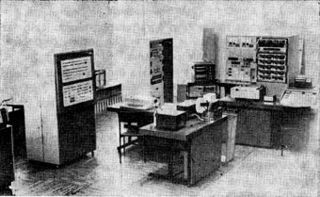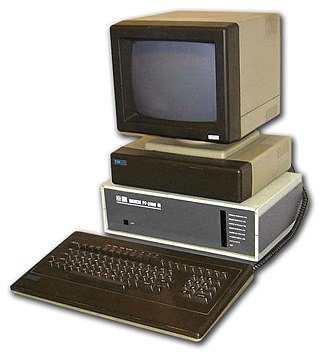
The Intel 80286 is a 16-bit microprocessor that was introduced on February 1, 1982. It was the first 8086-based CPU with separate, non-multiplexed address and data buses and also the first with memory management and wide protection abilities. The 80286 used approximately 134,000 transistors in its original nMOS (HMOS) incarnation and, just like the contemporary 80186, it can correctly execute most software written for the earlier Intel 8086 and 8088 processors.

The 8086 is a 16-bit microprocessor chip designed by Intel between early 1976 and June 8, 1978, when it was released. The Intel 8088, released July 1, 1979, is a slightly modified chip with an external 8-bit data bus, and is notable as the processor used in the original IBM PC design.

The Intel 386, originally released as 80386 and later renamed i386, is a 32-bit microprocessor designed by Intel. The first pre-production samples of the 386 were released to select developers in 1985, while mass production commenced in 1986. The processor was a significant evolution in the x86 architecture, extending a long line of processors that stretched back to the Intel 8008. The 386 was the central processing unit (CPU) of many workstations and high-end personal computers of the time. The 386 began to fall out of public use starting with the release of the i486 processor in 1989, while in embedded systems the 386 remained in widespread use until Intel finally discontinued it in 2007.

The Intel 80186, also known as the iAPX 186, or just 186, is a microprocessor and microcontroller introduced in 1982. It was based on the Intel 8086 and, like it, had a 16-bit external data bus multiplexed with a 20-bit address bus. The 80188 variant, with an 8-bit external data bus was also available.
A source-to-source translator, source-to-source compiler, transcompiler, or transpiler is a type of translator that takes the source code of a program written in a programming language as its input and produces an equivalent source code in the same or a different programming language. A source-to-source translator converts between programming languages that operate at approximately the same level of abstraction, while a traditional compiler translates from a higher level programming language to a lower level programming language. For example, a source-to-source translator may perform a translation of a program from Python to JavaScript, while a traditional compiler translates from a language like C to assembly or Java to bytecode. An automatic parallelizing compiler will frequently take in a high level language program as an input and then transform the code and annotate it with parallel code annotations or language constructs.

CER model 10 was a vacuum tube, transistor and electronic relay based computer developed at IBK-Vinča and the Mihajlo Pupin Institute (Belgrade) in 1960. It was the first digital computer developed in SFR Yugoslavia, and in Southern Europe.

CER model 22 is a transistor based computer developed by Mihajlo Pupin Institute (Serbia) in 1967-1968. It was originally intended for banking applications and was used for data processing and management planning in banks, trade and utility companies in Belgrade. Three CER-22 computers were purchased by Beobanka, Jugopetrol and BVK–Belgrade companies..
CER was a series of early computers developed by Mihajlo Pupin Institute in Yugoslavia in the 1960s and 1970s.

Mihajlo Pupin Institute is an institute based in Belgrade, Serbia. It is named after Mihajlo Idvorski Pupin and is part of the University of Belgrade.

CER model 12 was a third-generation digital computer developed by Mihajlo Pupin Institute (Serbia) in 1971 and intended for "business and statistical data processing". However, the manufacturer also stated, at the time, that having in mind its architecture and performance, it can also be used successfully in solving "wide array of scientific and technical issues". Computer CER-12 consisted of multiple modules connected via wire wrap and connectors.

The Socialist Federal Republic of Yugoslavia (SFRY) was a socialist country that existed in the second half of the 20th century. Being socialist meant that strict technology import rules and regulations shaped the development of computer history in the country, unlike in the Western world. However, since it was a non-aligned country, it had no ties to the Soviet Bloc either. One of the major ideas contributing to the development of any technology in SFRY was the apparent need to be independent of foreign suppliers for spare parts, fueling domestic computer development.

HRS-100, ХРС-100, GVS-100 or ГВС-100, was a third generation hybrid computer developed by Mihajlo Pupin Institute and engineers from USSR in the period from 1968 to 1971. Three systems HRS-100 were deployed in Academy of Sciences of USSR in Moscow and Novosibirsk (Akademgorodok) in 1971 and 1978. More production was contemplated for use in Czechoslovakia and German Democratic Republic (DDR), but that was not realised.

TIM 011 is an educational or personal computer for school microcomputer developed by Mihajlo Pupin Institute of Serbia in 1987. There were about 1200 TIM-011 computers in Serbian schools in the starting from 1987 and in 1990s.

TIM-001 was an application development microcomputer developed by Mihajlo Pupin Institute (Serbia) in 1983/84.

Micral is a series of microcomputers produced by the French company Réalisation d'Études Électroniques, beginning with the Micral N in early 1973. The Micral N was one of the first commercially available microprocessor-based computers.
Each time Intel launched a new microprocessor, they simultaneously provided a system development kit (SDK) allowing engineers, university students, and others to familiarise themselves with the new processor's concepts and features. The SDK single-board computers allowed the user to enter object code from a keyboard or upload it through a communication port, and then test run the code. The SDK boards provided a system monitor ROM to operate the keyboard and other interfaces. Kits varied in their specific features but generally offered optional memory and interface configurations, a serial terminal link, audio cassette storage, and EPROM program memory. Intel's Intellec development system could download code to the SDK boards.
In computer architecture, 16-bit integers, memory addresses, or other data units are those that are 16 bits wide. Also, 16-bit central processing unit (CPU) and arithmetic logic unit (ALU) architectures are those that are based on registers, address buses, or data buses of that size. 16-bit microcomputers are microcomputers that use 16-bit microprocessors.

The ATLAS-TIM AT 32 was the process computer developed by Mihajlo Pupin Institute in Belgrade in the 1980s. The designers were Dr Vukasin Masnikosa, Dr Bozidar Levi, Mr Milenko Nikolic and their associates. Professor Bozidar Levi with 2 coauthors got the Nikola Tesla award for his ATLAS design in 1988.

TIM-600 was an important PC computer system in the TIM series of microcomputers from Mihajlo Pupin Institute-Belgrade, developed from 1987 to 1988. It was based on the Intel microprocessor types 80386 and 80387. It has word-length of 32 bits, basic cycle time of 20 MHz and operating system Unix V.3. The TIM-600 computer system was presented at the Munich International Computer Exhibition in September 1988.

CER-11 was a portable digital military computer, developed at Institute Mihajlo Pupin, located in Serbia, in a period between 1965 and 1966.


















